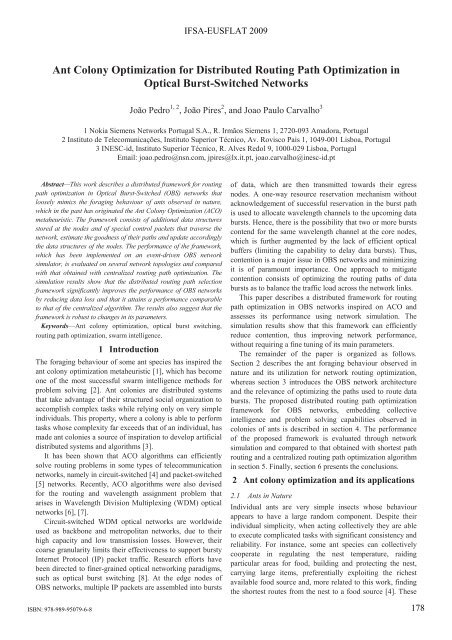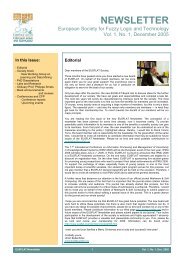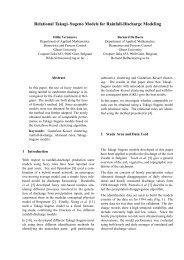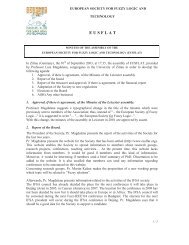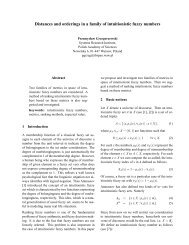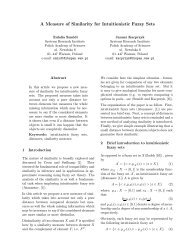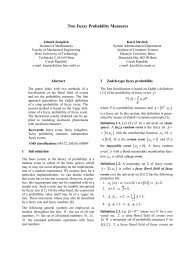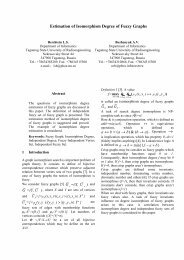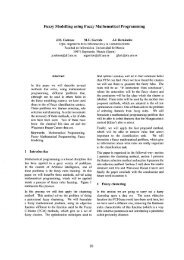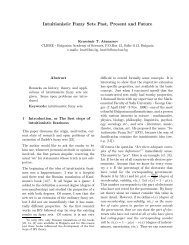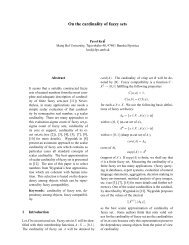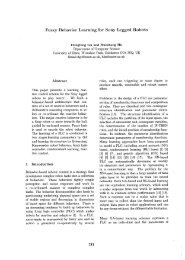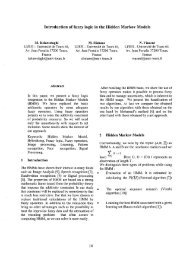Ant Colony Optimization for Distributed Routing ... - ResearchGate
Ant Colony Optimization for Distributed Routing ... - ResearchGate
Ant Colony Optimization for Distributed Routing ... - ResearchGate
Create successful ePaper yourself
Turn your PDF publications into a flip-book with our unique Google optimized e-Paper software.
<strong>Ant</strong> <strong>Colony</strong> <strong>Optimization</strong> <strong>for</strong> <strong>Distributed</strong> <strong>Routing</strong> Path <strong>Optimization</strong> in<br />
Optical Burst-Switched Networks<br />
João Pedro 1, 2 , João Pires 2 , and Joao Paulo Carvalho 3<br />
1 Nokia Siemens Networks Portugal S.A., R. Irmãos Siemens 1, 2720-093 Amadora, Portugal<br />
2 Instituto de Telecomunicações, Instituto Superior Técnico, Av. Rovisco Pais 1, 1049-001 Lisboa, Portugal<br />
3 INESC-id, Instituto Superior Técnico, R. Alves Redol 9, 1000-029 Lisboa, Portugal<br />
Email: joao.pedro@nsn.com, jpires@lx.it.pt, joao.carvalho@inesc-id.pt<br />
Abstract—This work describes a distributed framework <strong>for</strong> routing<br />
path optimization in Optical Burst-Switched (OBS) networks that<br />
loosely mimics the <strong>for</strong>aging behaviour of ants observed in nature,<br />
which in the past has originated the <strong>Ant</strong> <strong>Colony</strong> <strong>Optimization</strong> (ACO)<br />
metaheuristic. The framework consists of additional data structures<br />
stored at the nodes and of special control packets that traverse the<br />
network, estimate the goodness of their paths and update accordingly<br />
the data structures of the nodes. The per<strong>for</strong>mance of the framework,<br />
which has been implemented on an event-driven OBS network<br />
simulator, is evaluated on several network topologies and compared<br />
with that obtained with centralized routing path optimization. The<br />
simulation results show that the distributed routing path selection<br />
framework significantly improves the per<strong>for</strong>mance of OBS networks<br />
by reducing data loss and that it attains a per<strong>for</strong>mance comparable<br />
to that of the centralized algorithm. The results also suggest that the<br />
framework is robust to changes in its parameters.<br />
Keywords—<strong>Ant</strong> colony optimization, optical burst switching,<br />
routing path optimization, swarm intelligence.<br />
1 Introduction<br />
The <strong>for</strong>aging behaviour of some ant species has inspired the<br />
ant colony optimization metaheuristic [1], which has become<br />
one of the most successful swarm intelligence methods <strong>for</strong><br />
problem solving [2]. <strong>Ant</strong> colonies are distributed systems<br />
that take advantage of their structured social organization to<br />
accomplish complex tasks while relying only on very simple<br />
individuals. This property, where a colony is able to per<strong>for</strong>m<br />
tasks whose complexity far exceeds that of an individual, has<br />
made ant colonies a source of inspiration to develop artificial<br />
distributed systems and algorithms [3].<br />
It has been shown that ACO algorithms can efficiently<br />
solve routing problems in some types of telecommunication<br />
networks, namely in circuit-switched [4] and packet-switched<br />
[5] networks. Recently, ACO algorithms were also devised<br />
<strong>for</strong> the routing and wavelength assignment problem that<br />
arises in Wavelength Division Multiplexing (WDM) optical<br />
networks [6], [7].<br />
Circuit-switched WDM optical networks are worldwide<br />
used as backbone and metropolitan networks, due to their<br />
high capacity and low transmission losses. However, their<br />
coarse granularity limits their effectiveness to support bursty<br />
Internet Protocol (IP) packet traffic. Research ef<strong>for</strong>ts have<br />
been directed to finer-grained optical networking paradigms,<br />
such as optical burst switching [8]. At the edge nodes of<br />
OBS networks, multiple IP packets are assembled into bursts<br />
ISBN: 978-989-95079-6-8<br />
IFSA-EUSFLAT 2009<br />
of data, which are then transmitted towards their egress<br />
nodes. A one-way resource reservation mechanism without<br />
acknowledgement of successful reservation in the burst path<br />
is used to allocate wavelength channels to the upcoming data<br />
bursts. Hence, there is the possibility that two or more bursts<br />
contend <strong>for</strong> the same wavelength channel at the core nodes,<br />
which is further augmented by the lack of efficient optical<br />
buffers (limiting the capability to delay data bursts). Thus,<br />
contention is a major issue in OBS networks and minimizing<br />
it is of paramount importance. One approach to mitigate<br />
contention consists of optimizing the routing paths of data<br />
bursts as to balance the traffic load across the network links.<br />
This paper describes a distributed framework <strong>for</strong> routing<br />
path optimization in OBS networks inspired on ACO and<br />
assesses its per<strong>for</strong>mance using network simulation. The<br />
simulation results show that this framework can efficiently<br />
reduce contention, thus improving network per<strong>for</strong>mance,<br />
without requiring a fine tuning of its main parameters.<br />
The remainder of the paper is organized as follows.<br />
Section 2 describes the ant <strong>for</strong>aging behaviour observed in<br />
nature and its utilization <strong>for</strong> network routing optimization,<br />
whereas section 3 introduces the OBS network architecture<br />
and the relevance of optimizing the paths used to route data<br />
bursts. The proposed distributed routing path optimization<br />
framework <strong>for</strong> OBS networks, embedding collective<br />
intelligence and problem solving capabilities observed in<br />
colonies of ants is described in section 4. The per<strong>for</strong>mance<br />
of the proposed framework is evaluated through network<br />
simulation and compared to that obtained with shortest path<br />
routing and a centralized routing path optimization algorithm<br />
in section 5. Finally, section 6 presents the conclusions.<br />
2 <strong>Ant</strong> colony optimization and its applications<br />
2.1 <strong>Ant</strong>s in Nature<br />
Individual ants are very simple insects whose behaviour<br />
appears to have a large random component. Despite their<br />
individual simplicity, when acting collectively they are able<br />
to execute complicated tasks with significant consistency and<br />
reliability. For instance, some ant species can collectively<br />
cooperate in regulating the nest temperature, raiding<br />
particular areas <strong>for</strong> food, building and protecting the nest,<br />
carrying large items, preferentially exploiting the richest<br />
available food source and, more related to this work, finding<br />
the shortest routes from the nest to a food source [4]. These<br />
178
elatively complex tasks seem to emerge from interactions<br />
between large numbers of ants and their environment. In<br />
some cases, individual ants coordinate their activities using a<br />
principle known as stigmergy [1], whose main characteristics<br />
are: (i) indirect and non-symbolic <strong>for</strong>m of communication<br />
mediated by the environment, that is, ants exchange<br />
in<strong>for</strong>mation by modifying their environment; (ii) stigmergic<br />
in<strong>for</strong>mation is local, which means that it can only be<br />
accessed by ants that visit the immediate vicinity of the place<br />
where it was released.<br />
The communication between individual ants is based on<br />
the use of specific chemicals, called pheromones.<br />
Particularly important <strong>for</strong> the social life of some ant species<br />
is the trail pheromone, which is a specific type of pheromone<br />
they use <strong>for</strong> marking paths on the ground. While walking<br />
between food sources and the nest, ants deposit pheromones<br />
on the ground, <strong>for</strong>ming a pheromone trail. Subsequent ants<br />
sense the pheromone and tend to choose, probabilistically,<br />
paths with a stronger pheromone concentration, further<br />
rein<strong>for</strong>cing it. After some time, ants converge to use a single<br />
shortest path. A compendium of seminal works on the<br />
pheromone trail-laying and trail-following behaviour of some<br />
ant species can be found in [3].<br />
2.2 <strong>Ant</strong> <strong>Colony</strong> <strong>Optimization</strong> <strong>for</strong> Network <strong>Routing</strong><br />
The basic idea underlying ant colony-based algorithms and<br />
systems is to use a <strong>for</strong>m of artificial stigmergy to coordinate<br />
the activities of artificial agents. The majority of ACO<br />
applications have been <strong>for</strong> solving -hard problems, <strong>for</strong><br />
which the best known algorithms that guarantee an optimal<br />
solution have an exponential time worst case complexity. In<br />
some of these problems, ACO algorithms have been shown<br />
to determine high-quality, although not guaranteed to be<br />
optimal, solutions in relatively short time.<br />
The routing problems in telecommunication networks are<br />
particularly interesting <strong>for</strong> ACO, because the intrinsically<br />
distributed nature of ACO can fit well with them. However,<br />
these problems pose additional challenges, because the<br />
routing algorithm should also be able to react rapidly to<br />
changing network and traffic conditions and to maintain<br />
exploration capabilities so that it can effectively evaluate<br />
alternative paths which, in view of the problem dynamics,<br />
can become the best ones at some point in time [1].<br />
The different ACO algorithms <strong>for</strong> network routing have in<br />
common the fact that pheromone tables are stored at the<br />
network nodes and artificial agents, typically in the <strong>for</strong>m of<br />
control packets, are employed to collect node/link state<br />
in<strong>for</strong>mation and update the pheromone tables. ACO was first<br />
applied to network routing in circuit-switched networks, like<br />
the Plain Old Telephone Service (POTS), in [3]. The main<br />
purpose of <strong>Ant</strong>-Based Control (ABC) is to relieve congestion<br />
on the network by preferably routing calls (circuits) via parts<br />
of the network with larger spare capacity, consequently<br />
reducing call blocking probability. Later, ACO was applied<br />
to routing in packet-switched networks, such as IP networks,<br />
in [5]. These networks use store-and-<strong>for</strong>ward nodes, which<br />
contain buffers to store the incoming packets and delay them<br />
until there is free capacity on the preferred output link. With<br />
ISBN: 978-989-95079-6-8<br />
IFSA-EUSFLAT 2009<br />
<strong>Ant</strong>Net [5], an artificial ant is launched at regular intervals of<br />
time from a network node towards another node to discover a<br />
low-cost path between the nodes and to investigate the load<br />
status of the network. The selection of the next node by an<br />
ant is made by assigning to the neighbouring nodes a<br />
probability of being selected that depends not only on the<br />
correspondent pheromone value but also on the occupancy of<br />
the queue associated to the link between the current node and<br />
the neighbouring node. Hence, the chances of selecting a<br />
neighbouring node increase with its pheromone value but<br />
decrease with the queue waiting time associated to it.<br />
ACO has also found application on routing in optical<br />
WDM networks, both in Optical Circuit-Switched (OCS) [6],<br />
[7] and Optical Packet-Switched (OPS) networks [9]. <strong>Ant</strong>Net<br />
was adapted in [9] <strong>for</strong> load balancing in OPS networks. The<br />
nodes of these networks use Fibre Delay Line (FDL) buffers,<br />
which have a very limited contention resolution capability,<br />
when compared to electronic buffers. The proposal modifies<br />
the solution construction phase of the original <strong>Ant</strong>Net<br />
implementation [5] using a suitable expression <strong>for</strong> computing<br />
the buffer occupancy, since FDL buffers behave differently<br />
from electronic buffers.<br />
Despite the recent research activity aiming to use ACO <strong>for</strong><br />
routing in optical WDM networks, both in OCS and OPS, to<br />
the best of the author’s knowledge ACO has not yet been<br />
adapted to the case of OBS networks.<br />
3 Optical burst-switched networks<br />
In current optical transport networks, circuits are established<br />
between nodes during long periods of time (weeks, months)<br />
using wavelength channels with a capacity of several Gbit/s<br />
each. However, the dominant IP packet traffic carried over<br />
these networks significantly fluctuates over relatively small<br />
time scales. Hence, current circuit-switched optical networks<br />
are inefficient to support this type of traffic due to both their<br />
coarse granularity and slow circuit setup time. OPS networks<br />
would provide the best adaptation between the IP traffic and<br />
the optical network resources used, but they cannot be<br />
implemented with state-of-the-art technology, namely due to<br />
the already referred lack of efficient optical buffers. OBS<br />
networks have attracted considerable interest because their<br />
switching granularity and optical technology complexity are<br />
in between those of OCS and OPS [10].<br />
3.1 Network Architecture<br />
At the ingress edge nodes of OBS networks, IP packets are<br />
assembled into large chunks of data, called bursts. Each data<br />
burst is transmitted using a wavelength channel and must be<br />
switched at the core nodes until it reaches the egress edge<br />
node, where it is disassembled and its packets delivered to<br />
the local IP network. Resource reservation <strong>for</strong> each burst is<br />
made using a control message, known as Burst Header<br />
Packet (BHP), sent ahead of the data burst on a separate<br />
wavelength channel. Each node along the routing path of the<br />
burst processes the BHP and configures its switching matrix<br />
to direct the upcoming data burst to an available wavelength<br />
channel on the appropriate output fibre link. The interested<br />
reader can find more in<strong>for</strong>mation on OBS networks in [10].<br />
179
3.2 <strong>Routing</strong> Path <strong>Optimization</strong><br />
In OBS networks, multiple data bursts, overlapping in time,<br />
may contend at a node <strong>for</strong> the same wavelengths of an output<br />
fibre link. Unresolved contention leads to dropping some of<br />
the data bursts, degrading network per<strong>for</strong>mance. There<strong>for</strong>e,<br />
it is important to minimize the probability that the number of<br />
overlapping data bursts directed to a fibre link exceeds the<br />
number of wavelength channels. This can be achieved by<br />
optimizing the routing paths in order to balance the traffic<br />
load offered to the network links, reducing the traffic load on<br />
the most congested links at the expense of increasing it on<br />
the less congested ones.<br />
<strong>Routing</strong> path optimization can either be centralized, when<br />
all the paths are computed at a central point of the network<br />
using global in<strong>for</strong>mation of the offered traffic load [11], or<br />
distributed [12]. Although centralized strategies can reduce<br />
contention more efficiently, by exploiting global knowledge<br />
of the network state, distributed strategies are often preferred<br />
because they are more scalable and robust and faster to adapt<br />
the routing paths to changes in the traffic pattern.<br />
4 <strong>Distributed</strong> <strong>Ant</strong>-inspired Burst <strong>Routing</strong><br />
The framework <strong>for</strong> distributed routing path optimization in<br />
OBS networks proposed in this work is based on principles<br />
of ACO. Although it inherits some concepts from previous<br />
ACO algorithms <strong>for</strong> network routing, such as <strong>Ant</strong>Net and<br />
ABC, the proposed <strong>Distributed</strong> <strong>Ant</strong>-inspired Burst <strong>Routing</strong><br />
(DABR) framework was specifically designed <strong>for</strong> bufferless<br />
OBS networks and incorporates functions that account <strong>for</strong><br />
the particular characteristics of these networks.<br />
Common to all applications of ACO <strong>for</strong> network routing,<br />
the DABR framework uses artificial ants, in the <strong>for</strong>m of<br />
control packets, and data structures at the network nodes to<br />
support stigmergic communication between the artificial<br />
ants. The key features of DABR are:<br />
Forward ants carry a fictitious data burst reservation<br />
and, at each node, the instantaneous congestion of the<br />
output fibre links is evaluated based on the number of<br />
wavelengths available to transmit the fictitious burst.<br />
Backward ants update the pheromone tables using the<br />
congestion in<strong>for</strong>mation collected by the <strong>for</strong>ward ants<br />
as input to a loss per<strong>for</strong>mance model that estimates<br />
the burst blocking probability on the path traversed by<br />
the <strong>for</strong>ward ant.<br />
In order to mitigate path stagnation, three mechanisms<br />
are used: the routing of <strong>for</strong>ward ants employs both a<br />
minimum pheromone concentration per adjacent node<br />
(noise) and pheromone-heuristic control, whereas the<br />
backward ants use privileged pheromone laying [13].<br />
The nodes keep separate routing and pheromone<br />
tables because an additional path integrity mechanism<br />
is used to completely avoid circular path <strong>for</strong>mation.<br />
Consider an OBS network modelled as a directed graph<br />
G = (V, E), where N = |V| is the number of nodes and L = |E|<br />
is the number of unidirectional fibre links. Assume each fibre<br />
link supports a set of W wavelengths, {λ1, λ2, …, λW–1, λW}.<br />
The following sub-sections describe the DABR framework.<br />
ISBN: 978-989-95079-6-8<br />
IFSA-EUSFLAT 2009<br />
4.1 Control Packets and Local Data Structures<br />
In DABR, artificial ants are transmitted on the control<br />
channel as modified BHPs. Two types of artificial ants are<br />
used: Explorer <strong>Ant</strong> Packet (EAP) and Referee <strong>Ant</strong> Packet<br />
(RAP). The <strong>for</strong>mer ant is used to collect in<strong>for</strong>mation on the<br />
resource availability along a given routing path and to update<br />
the pheromone tables, loosely mimicking the behaviour of<br />
real ants, whereas the latter one is used to avoid circular path<br />
<strong>for</strong>mation. Both EAP and RAP have two modes of operation:<br />
<strong>for</strong>ward (F), from the ingress to the egress node, and<br />
backward (B), in the reverse path. Two data structures are<br />
stored at each node: one pheromone table and one routing<br />
table. The pheromone table is used <strong>for</strong> routing the F-EAPs<br />
and it is updated in their return trips as B-EAPs. The routing<br />
table can only be updated by RAPs.<br />
Unlike previous ACO routing algorithms, routing of<br />
artificial ants and data bursts in DABR is based not only on<br />
the egress node but also on the ingress node, providing an<br />
additional degree of freedom <strong>for</strong> load balancing at the<br />
expense of increasing the size of the tables. Let Ai denote the<br />
set of adjacent nodes of i ∈ V (nodes connected to i by a<br />
sd<br />
fibre link) and ij denote the pheromone value associated to<br />
using node j ∈ Ai to route at node i a burst generated at s and<br />
directed to d. The sum of the pheromone values related with<br />
the same ingress and egress node pair must equal one,<br />
sd<br />
ij<br />
j∈Ai<br />
= 1,<br />
i,<br />
s,<br />
d ∈V<br />
, s ≠ d . (1)<br />
Let hij denote the number of links of the shortest path<br />
between i and j. The pheromone tables are initialized as to be<br />
slightly biased towards the shortest paths,<br />
<br />
sd<br />
ij<br />
( 1+<br />
h )<br />
1 jd<br />
<br />
<br />
1 kd<br />
k Ai<br />
<br />
0,<br />
otherwise<br />
= ∈<br />
( 1+<br />
h )<br />
, j ∈ Ai<br />
, i ≠ d,<br />
s ≠ d<br />
. (2)<br />
4.2 <strong>Routing</strong> of Forward Explorer <strong>Ant</strong>s<br />
Each time node s assembles a data burst directed to d, it<br />
generates with probability pant, where 0 < pant 1, an F-EAP<br />
that is routed from s to d to collect in<strong>for</strong>mation on the<br />
resource availability of a particular path. The F-EAP carries<br />
a fictitious burst reservation request whose duration equals<br />
that of the burst that triggered the generation of the artificial<br />
ant and a list VEAP with the nodes it has already visited.<br />
At each node i ∈ V visited by an F-EAP, the next node of<br />
its routing path is selected among the adjacent nodes not<br />
visited yet. In case Ai ⊆ VEAP, the F-EAP is dropped to avoid<br />
looping. Otherwise, the adjacent node j is selected with a<br />
sd<br />
probability p ij that is the normalized sum of the pheromone<br />
value and a heuristic value ηij that accounts <strong>for</strong> the resource<br />
availability on the fibre link between nodes i and j [5],<br />
p<br />
sd<br />
ij<br />
<br />
<br />
(1<br />
+ α )<br />
= <br />
<br />
<br />
+ ∈ ∉<br />
sd<br />
ij <br />
k∈Ai sd<br />
ik<br />
ij<br />
α<br />
, j<br />
(1 + α)<br />
ik<br />
k∈Ai Ai, j VEAP<br />
. (3)<br />
k∉VEAP k∉VEAP 0, otherwise<br />
180
The pheromone value is the result of pheromone laying by<br />
previous artificial ants and represents the long-term goodness<br />
of selecting the fibre link from i to j to route the F-EAP,<br />
whereas the heuristic value corresponds to the instantaneous<br />
goodness of selecting this fibre link. In order to compute ηij,<br />
the wavelength availability of the fibre link ij is assessed by<br />
determining if the fictitious data burst could be scheduled on<br />
each of the W wavelengths of the fibre link. Let ij denote<br />
the number of available wavelengths to schedule the data<br />
burst on this fibre link. The heuristic value ηij is given by<br />
= Wˆ W . (4)<br />
ij ij<br />
The link state weight α determines the importance of the<br />
instantaneous resource availability of the fibre link over its<br />
long-term pheromone concentration.<br />
The node selected j* is added to the F-EAP, as well as the<br />
number of available wavelengths ij*. When it reaches the<br />
egress node, the artificial ant is switched to B-EAP.<br />
4.3 Pheromone Table Update by Backward Explorer <strong>Ant</strong>s<br />
The B-EAP follows the reverse path of the F-EAP, updating<br />
the pheromone tables in each node. In an OBS network, the<br />
average burst blocking probability on a fibre link can be<br />
estimated with the Erlang-B <strong>for</strong>mula, assuming an average<br />
offered traffic load of x and a Poisson burst arrival process,<br />
( )<br />
k= 0 <br />
The wavelength availability ij, collected by the F-EAP,<br />
is used to estimate the traffic load offered to the fibre link<br />
between i and j as x = W – ij. Under the link independence<br />
assumption [14], the average burst blocking probability in<br />
the routing path between nodes s and d can be estimated by<br />
| VEAP<br />
| −1<br />
sd<br />
B = 1 − (1 ˆ ∏ −B<br />
vv ) , (6)<br />
k k+<br />
1<br />
k=<br />
1<br />
−1<br />
W<br />
W k <br />
Erl( xW , ) = x W! ⋅ x k!<br />
. (5)<br />
<br />
where { v 1, v2<br />
, ..., vk<br />
, ..., v|<br />
V | } denotes the ordered set of the<br />
EAP<br />
nodes visited by the F-EAP and B ˆ<br />
vv the average burst<br />
k k+<br />
1<br />
blocking probability in the fibre link between vk and vk+1. The<br />
goodness of a routing path is quantified in DABR as<br />
sd sd<br />
q = 1 B . (7)<br />
Each node i maintains the goodness of the best solution<br />
sd<br />
qbest estimated by the previous Q artificial ants between s<br />
and d and the pheromone rein<strong>for</strong>cement value r is given by<br />
sd sd sd sd<br />
q<br />
qbest , q < qbest<br />
r = . (8)<br />
1, otherwise<br />
In order to enhance the rewarding of good solutions (high<br />
values of r), while saturating the rewards <strong>for</strong> low values of r,<br />
the following squash function s(x) is used [5],<br />
ISBN: 978-989-95079-6-8<br />
−1<br />
EAP | |<br />
1 <br />
s ( x)<br />
= 1+<br />
exp <br />
<br />
<br />
<br />
<br />
<br />
r V <br />
, (9)<br />
r ← ⋅ s() r s(1)<br />
, (10)<br />
max<br />
IFSA-EUSFLAT 2009<br />
where τmax is the maximum pheromone value that a single<br />
artificial ant can deposit. This parameter is used to regulate<br />
the impact of a single artificial ant on the pheromone tables.<br />
The pheromone update has to ensure a minimum amount<br />
of pheromone τmin uni<strong>for</strong>mly divided by the adjacent nodes,<br />
sd<br />
ik ≥ min | Ai|, k∈ Ai,<br />
(11)<br />
and it also has to guarantee that equation (1) holds. Hence,<br />
the following expressions have been devised <strong>for</strong> updating the<br />
pheromone value associated to the adjacent node j the F-EAP<br />
has used and that associated to the remaining adjacent nodes,<br />
( 1 min (| | 1) | | )<br />
( min | | ) , ,<br />
sd sd sd<br />
ij ij r ij AiAi τ ← τ + ⋅ −τ − ⋅ − , (12)<br />
sd sd sd<br />
ik ik ik i i<br />
τ ←τ −r⋅ τ − A k∈A k ≠ j.<br />
(13)<br />
In case the update has modified the adjacent node that has<br />
the highest pheromone value, designated as the dominant<br />
adjacent node, a specific flag of the B-EAP is activated.<br />
4.4 <strong>Routing</strong> Table Update and Circular Path Avoidance<br />
In the initial implementation of DABR, data bursts were<br />
routed through the path obtained from the adjacent nodes<br />
with the largest pheromone concentration. However, it was<br />
found that circular paths were occasionally <strong>for</strong>med, which<br />
resulted in data bursts getting trapped on a loop. Although<br />
these paths are only temporary, the resulting communication<br />
disruption is not tolerable in a high capacity optical network.<br />
Hence, it is imperative to include in DABR a mechanism to<br />
avoid the <strong>for</strong>mation of circular paths. The novel mechanism<br />
devised <strong>for</strong> this purpose separates the pheromone and routing<br />
tables, guaranteeing that the update of the routing paths<br />
never allows the <strong>for</strong>mation of loops without introducing<br />
additional restrictions to the update of the pheromone tables.<br />
sd<br />
Let v i denote the adjacent node of node i used <strong>for</strong><br />
routing data bursts from node s to node d. The update of the<br />
routing path between s and d is triggered by the arrival at<br />
node s of a B-EAP with the flag that signals a new dominant<br />
adjacent node activated. As a result, node s generates a F-<br />
RAP directed to node d. This control packet includes a list to<br />
record the nodes it visits. At each node i the F-RAP visits,<br />
the dominant adjacent node j* is determined, that is,<br />
*<br />
j = arg max τ<br />
j∈Ai sd { }<br />
ij<br />
, (14)<br />
and compared with the nodes previously visited. In case node<br />
j* has already been visited, a loop is detected and the F-RAP<br />
is discarded, keeping the routing path unchanged. Otherwise,<br />
the F-RAP adds the dominant adjacent node j* to the list of<br />
nodes visited and moves to it. In case j* = d, the new routing<br />
path is non-circular. Thus, the F-RAP is switched to B-RAP,<br />
follows the inverse path and, at each node i, the adjacent<br />
node used to route data bursts, sd<br />
v i , is updated to be the<br />
same as the node visited by the F-RAP immediately after i.<br />
The routing of data bursts in DABR is determined by the<br />
routing tables of the nodes. In particular, when a BHP,<br />
preceding the correspondent data burst, arrives at node i, the<br />
sd<br />
node determines the next node of the data burst from v i .<br />
181
5 Simulation Results<br />
In OBS networks, the most relevant per<strong>for</strong>mance metric is<br />
the average burst blocking probability. The loss per<strong>for</strong>mance<br />
of OBS networks is evaluated using the network simulator of<br />
[15] modified to support DABR. All the simulations use the<br />
JET resource reservation mechanism [8], each fibre link has<br />
W=32 wavelength channels, each with a capacity µ=10 Gb/s,<br />
the time to process one BHP or artificial packet is 100 µs<br />
and the switch fabric configuration time is 160 µs. The burst<br />
size and interarrival time are exponentially distributed and<br />
the average burst size is 10 MB. The average offered traffic<br />
load normalized to the network capacity is given by<br />
<br />
sd<br />
⋅ h<br />
s, d ∈ V sd<br />
=<br />
, (15)<br />
L⋅W ⋅<br />
where γ sd is the average offered traffic load between nodes s<br />
and d. The per<strong>for</strong>mance evaluation is made with the network<br />
topologies of Fig. 1, assuming a uni<strong>for</strong>m traffic pattern <strong>for</strong><br />
EON and a non-uni<strong>for</strong>m traffic pattern <strong>for</strong> COST 239. The<br />
average burst blocking probability and a 95% confidence<br />
interval on this value are obtained from 10 independent<br />
simulations with 5×10 6 data bursts each.<br />
<br />
<br />
<br />
<br />
<br />
<br />
<br />
<br />
<br />
<br />
<br />
(a) COST 239 (b) EON<br />
Figure 1: Network topologies.<br />
Figure 2 plots the average burst blocking probability as a<br />
function of the average offered traffic load <strong>for</strong> the COST 239<br />
and EON networks, respectively. The parameters used <strong>for</strong><br />
DABR are pant=0.05, α=0.25, τmin=0.2, τmax=0.1, and Q=50,<br />
aiming a compromise between per<strong>for</strong>mance and adaptability<br />
to changing conditions. For comparison purposes the plots<br />
also include the per<strong>for</strong>mance obtained with Shortest Path<br />
<strong>Routing</strong> (SPR) and the centralized HMNC algorithm of [11].<br />
The simulation results show that the per<strong>for</strong>mance obtained<br />
with DABR lies between that of SPR and HMNC, although<br />
always closer to the latter. This is an expected outcome. On<br />
one hand, the simpler SPR does not optimize the traffic load<br />
distribution over the fiber links, which can significantly<br />
increase contention in some of the links. On the other hand,<br />
the HMNC algorithm is more effective because it exploits<br />
the global knowledge of accurate traffic statistics. However,<br />
in more dynamic traffic scenarios, where traffic statistics are<br />
less reliable, HMNC may become less effective than the<br />
proposed DABR. The simulation results also show that<br />
larger confidence intervals are obtained with DABR than that<br />
with SPR and HMNC. This is a consequence of the online<br />
modification of the routing paths observed when using<br />
DABR, while with SPR and HMNC the same set of routing<br />
paths is used during the entire simulation.<br />
ISBN: 978-989-95079-6-8<br />
IFSA-EUSFLAT 2009<br />
a<br />
Average burst blocking probability<br />
a<br />
Average burst blocking probability<br />
1.0E+0 10 0<br />
1.0E-1 10 -1<br />
1.0E-2 10 -2<br />
1.0E-3 10 -3<br />
1.0E-4 10 -4<br />
1.0E-5 10 -5<br />
1.0E+0 10 0<br />
1.0E-1 10 -1<br />
1.0E-2 10 -2<br />
1.0E-3 10 -3<br />
1.0E-4 10 -4<br />
1.0E-5 10 -5<br />
SPR<br />
DABR<br />
HMNC<br />
0.10 0.20 0.30 0.40 0.50 0.60 0.70 0.80<br />
Average offered traffic load, Γ<br />
(a) 11-node COST 239 network<br />
SPR<br />
DABR<br />
HMNC<br />
0.15 0.25 0.35 0.45 0.55 0.65 0.75<br />
Average offered traffic load, Γ<br />
(b) 19-node EON network<br />
Figure 2: Network per<strong>for</strong>mance of DABR, SPR and HMNC.<br />
The per<strong>for</strong>mance impact of varying some of the<br />
parameters of DABR is assessed in the COST 239 network.<br />
In all cases, the parameter values given above are used with<br />
the exception of the parameter being varied. The average<br />
burst blocking probability as a function of the minimum<br />
pheromone value, maximum pheromone increment per EAP<br />
and size of sliding window used to record the best EAP<br />
solution are plotted in Figures 3, 4 and 5, respectively.<br />
a<br />
Average burst blocking probability<br />
1.0E+0 10 0<br />
1.0E-1 10 -1<br />
1.0E-2 10 -2<br />
1.0E-3 10 -3<br />
1.0E-4 10 -4<br />
1.0E-5 10 -5<br />
Γ=0.45<br />
Γ=0.35<br />
Γ=0.25<br />
0.00 0.10 0.20 0.30 0.40 0.50 0.60 0.70 0.80 0.90 1.00<br />
Minimum pheromone concentration, τmin<br />
Figure 3: Per<strong>for</strong>mance impact of τmin.<br />
182
a<br />
Average burst blocking probability<br />
a<br />
Average burst blocking probability<br />
1.0E+0 10 0<br />
1.0E-1 10 -1<br />
1.0E-2 10 -2<br />
1.0E-3 10 -3<br />
1.0E-4 10 -4<br />
1.0E-5 10 -5<br />
1.0E+0 10 0<br />
1.0E-1 10 -1<br />
1.0E-2 10 -2<br />
1.0E-3 10 -3<br />
1.0E-4 10 -4<br />
1.0E-5 10 -5<br />
Γ=0.45<br />
Γ=0.35<br />
Γ=0.25<br />
0.05 0.15 0.25 0.35 0.45 0.55 0.65 0.75<br />
Maximum pheromone increment per EAP, τmax<br />
Figure 4: Per<strong>for</strong>mance impact of τmax.<br />
Γ=0.45<br />
Γ=0.35<br />
Γ=0.25<br />
10 30 50 70 90 110 130 150 170 190<br />
Size of sliding window used to record the best EAP solution, Q<br />
Figure 5: Per<strong>for</strong>mance impact of Q.<br />
The results above consider three values of average offered<br />
traffic load in order to confirm that the behaviour observed is<br />
independent of the traffic load. According to the simulation<br />
results of Fig. 3, the loss per<strong>for</strong>mance slightly deteriorates as<br />
the minimum pheromone concentration on the adjacent<br />
nodes is increased. This is because the random component of<br />
routing the EAPs becomes larger, increasing the chances of<br />
modifications in the routing paths. In the limit case τmin=1,<br />
the network cannot optimize the set of routing paths.<br />
From Fig. 4, it can be seen that the average burst blocking<br />
probability is slightly increased as the EAPs are allowed to<br />
deposit more pheromone in a single trip. This behaviour is<br />
attributed to more frequent modifications of the routing paths<br />
as a consequence of increased fluctuations of the pheromone<br />
values. A smaller pheromone increment makes the routing<br />
paths less sensitive to the goodness of the solution found by a<br />
single artificial ant, which means they are changed only when<br />
a significant number of EAPs have followed a given routing<br />
path and confirmed its superior quality.<br />
As shown in Fig. 5, the use of a large Q can improve the<br />
network per<strong>for</strong>mance because it enhances the accuracy of the<br />
pheromone update process.<br />
Overall, given the relatively small range of variation of<br />
the average burst blocking probability, the results suggest<br />
ISBN: 978-989-95079-6-8<br />
IFSA-EUSFLAT 2009<br />
that DABR is quite robust to changes in its main parameters.<br />
The results also suggest that a larger Q and a smaller τmin and<br />
τmax slightly improve loss per<strong>for</strong>mance. However, it should<br />
be stressed that the simulations consider a single traffic<br />
pattern (in terms of average offered traffic load), whereas in<br />
more dynamic traffic scenarios a very large Q and very small<br />
τmin and τmax should be avoided because they can slow down<br />
the convergence to a new set of optimized routing paths<br />
whenever significant changes in the traffic pattern take place.<br />
6 Conclusions<br />
This paper has proposed a novel distributed routing path<br />
optimization framework <strong>for</strong> OBS networks based on ACO<br />
concepts. Simulation results have shown that the proposed<br />
framework can significantly improve network per<strong>for</strong>mance<br />
without needing to fine tune its parameters.<br />
References<br />
[1] M. Dorigo, M. Birattari and T. Stützle, <strong>Ant</strong> colony optimization:<br />
Artificial ants as a computational intelligence technique, IEEE<br />
Computational Intelligence Magazine, 1 (4): 28-39, Nov 2006.<br />
[2] E. Bonabeau, M. Dorigo and G. Theraulaz, Swarm Intelligence: From<br />
Natural to Artificial Systems, Ox<strong>for</strong>d University Press, 1999.<br />
[3] M. Dorigo and T. Stützle, <strong>Ant</strong> <strong>Colony</strong> <strong>Optimization</strong>, Cambridge: MIT<br />
Press, 2004.<br />
[4] R. Schoonderwoerd, O. Holland, J. Bruten and L. Rothkrantz, <strong>Ant</strong>based<br />
load balancing in telecommunications networks, Adaptive<br />
Behavior, 5 ( 2): 169-207, 1996.<br />
[5] G. Di Caro, and M. Dorigo, <strong>Ant</strong>Net: <strong>Distributed</strong> stigmergetic control<br />
<strong>for</strong> communications networks, Journal of Artificial Intelligence<br />
Research, 9: 317-365, 1998.<br />
[6] R. Garlick and R. Barr, Dynamic wavelength routing in WDM<br />
networks via ant colony optimization, in Proc. of International<br />
Workshop on <strong>Ant</strong> Algorithms (ANTS) 2002, 250-255, Brussels,<br />
Belgium.<br />
[7] S. Ngo, X. Jiang and S. Horiguchi, An ant-based approach to dynamic<br />
RWA in optical WDM networks, Photonic Network Communications,<br />
11 (1): 39-48, January 2006.<br />
[8] C. Qiao, and M. Yoo, Optical Burst Switching (OBS) – A new<br />
paradigm <strong>for</strong> an optical Internet, Journal of High Speed Networks, 8<br />
(1): 69-84, January 1999.<br />
[9] G. Pavani and H. Waldman, Traffic engineering and restoration in<br />
optical packet switching networks by means of ant colony<br />
optimization, in Proc. of BROADNETS 2006, San Jose, USA.<br />
[10] Y. Chen, C. Qiao and X. Yu, Optical burst switching: A new area in<br />
optical network research, IEEE Network, 18 (3): 16-23, May 2004.<br />
[11] J. Castro, J. Pedro and P. Monteiro, Burst loss reduction in OBS<br />
networks by minimizing network congestion, in Proc. of ConfTele<br />
2005, Tomar, Portugal.<br />
[12] G. Thodine, V. Vokkarane and J. Jue, Dynamic congestion-based load<br />
balanced routing in optical burst-switched networks, in Proc. of IEEE<br />
GLOBECOM 2003, 5: 2628-2632, San Francisco, USA.<br />
[13] K. Sim and W. Sun, <strong>Ant</strong> colony optimization <strong>for</strong> routing and loadbalancing:<br />
Survey and new directions, IEEE Transactions on Systems,<br />
Man, and Cybernetics, 33 (5): 560-572, September 2003.<br />
[14] F. Kelly, Loss networks, The Annals of Applied Probability, 1 (3):<br />
319-378, 1991.<br />
[15] J. Pedro, J. Castro, P. Monteiro and J. Pires, On the modelling and<br />
per<strong>for</strong>mance evaluation of optical burst-switched networks, in Proc.<br />
of IEEE CAMAD 2006, 30-37, Trento, Italy.<br />
183


